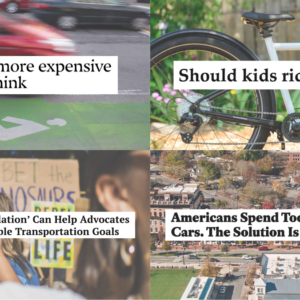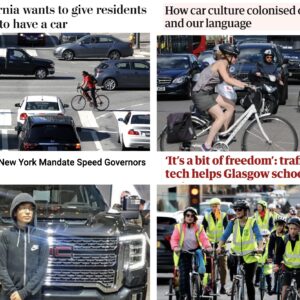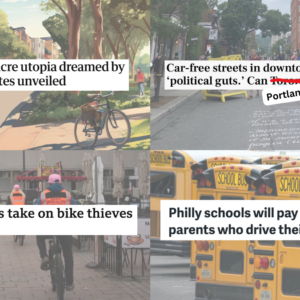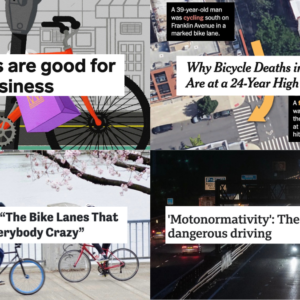
(Photo: GothPhil)
Good morning! Here are the bike links from around the world that caught our eyes this week:
Self-driving bike: Chinese search giant Baidu says it’s one-upping Google by prototyping an autonomous bicycle by the end of 2014.
Better taxis, fewer DUIs: In Philadelphia, San Francisco and Seattle, ridesharing and hailing apps (still illegal in Portland) seem to be reducing drunk-driving arrests.
Obsoleting car ownership: Helsinki, Finland, just announced plans to replace its current public transit network with a phone-activated system “kitting everything from driverless cars and nimble little buses to shared bikes and ferries into a single, supple mesh of mobility” that would be good enough to make car ownership pointless by 2025.
Biking as womanhood: “Cycling is awfully similar to being a woman. … Welcome to being vulnerable to the people around you. Welcome to being the exception, not the rule.”
Bike Rave: Momentum looks at the glowstick-lit ride that drew 7,000 riders in Vancouver BC this year.
Armstrong reconsidered: “Do we care what happens to the great work a man has done, after a great fall?” asks Esquire in a classy Lance Armstrong profile that looks at his charity success.
At least they can set goals: A year after Brazil’s transit fare protests, Sao Paolo says it’ll be the first city in the developing world to eliminate parking minimums and cap new parking spaces on transit lines at one space per residence.
Freakout of the week: Bikers who illegally ride on sidewalks in DC are “lucky that someone hasn’t put a broomstick through the spokes of their wheels,” writes a Washington Post columnist. Also bikers who slow traffic are “terrorists.”
Advertisement
E-bike crashes? With electric bicycles spreading fast in Tel Aviv, bike-pedestrian collision injuries soared 60 percent last year at a hospital there.
Unpredictable biking: “As a cyclist, I see a car coming and I am 99% confident that it will behave in a predictable manner, because drivers are trained to stick to the rules. Surely riders could do the same?” writes a UK resident. “What scares me the most as a cyclist is not the cars, not the lorries and not even the taxi passengers who unexpectedly wrench their door open in front of you – but other cyclists.” It’s the only anonymous column I’ve ever seen the Guardian publish.
Explaining sidewalk biking: Bike advocate Carlton Reid attempts to reframe the controversy by noting that governments turn some sidewalks into bad shared paths.
Vietnamese status shift: After decades when push-bikes were emblems of communistic simplicity, imported Treks and Specializeds are becoming status symbols in Hanoi.
Fixing CEQA: By abandoning “level of service,” California is about to reduce the penalty on projects that increase auto congestion and instead penalize projects that increase driving.
Highway removal: From coast to coast, cities are considering closing freeways and expressways through their hearts.
Splitting blame: A man who reported a truck passenger for throwing a Gatorade bottle at him while he was biking may himself be charged with “words in public likely to elicit a violent reaction.”
Bikes to burgers: A two-man 48-mile charity bike ride will visit all 11 Burgervilles in Clark County, Wash.
Unsolicited bridge plan: Wealthy Clark County Commissioner David Madore has privately ordered up the design work for what he says should be a new $600 million bridge across the Columbia River near his house.
And your video of the week is a very simple, fast-spreading trick for flash-free bike rides in skirts:
If you come across a noteworthy bicycle story, send it in via email, Tweet @bikeportland, or whatever else and we’ll consider adding it to next Monday’s roundup.





Thanks for reading.
BikePortland has served this community with independent community journalism since 2005. We rely on subscriptions from readers like you to survive. Your financial support is vital in keeping this valuable resource alive and well.
Please subscribe today to strengthen and expand our work.
I think you mean “fixing CEQA”, not SEPA (washington’s environmental law)?
You’re quite right. Fixed. Thanks.
Notably absent from the article on removing freeways was any mention of Portland.
When is the end-of-life date for I-5 on the east side of the river, and when will that (and the detested Marquam bridge) be removed to make way for a new East Waterfront Park?
Where would you move I-5 to?
Main idea in past, has been to put I-5 underground, obviously expensive, so it’s not been worth it yet to do that. I guess the Marquam is no beauty queen, but I’ve always kind of like its really tall columns for the way they allow sort of clear views with a lot of height between them from the waterfront. Its relatively flimsy construction posing a danger of it falling over in a quake is a concern.
Not sure that “falling over” is the failure mode for earthquakes, unless the foundation is crap. The elevated highway that fell down in Oakland back in 1989 failed from poorly engineered columns that more or less turned into delicate hinges and just dropped the upper deck on the lower deck — and it may be that the weight of the lower deck shaking on the “hinges” helped them give way. The pictures at the bottom here are instructive: http://en.wikipedia.org/wiki/Cypress_Street_Viaduct .
Which is not to say that the columns might not be flimsy, but it’s not the look, it’s the engineering of the rebar and pre-stress inside.
The mathematical importance of keeping concrete in compression and cables in tension is discussed here, perhaps with more math than most of us generally like: http://www2.kenyon.edu/Depts/Math/Paquin/LazerMcKenna.pdf
We can hope that concrete is properly pre-stressed all we want, the Marquam is going to careen into the river like a 7th grade popsicle stick project when we get our 4 minute long 7 pointer. Either we manage to scrounge up the money to replace it before then, or Mother Nature will make the decision for us.
They already did some retrofitting on the Marquim, you can see the steel cables tying the sections to the supports when viewed from underneath.
Anyways, the primary supports are concrete, but the secondary are all steel. For what its worth, the Seattle Alaskan Way viaduct was damaged enough in the 2001 earthquake to necessitate its removal, even though it was in use for years afterwards (its currently in the process of demolition and replacement by their stalled highway tunnel).
It’d be sweet if we could do realtime demand pricing on I-5 & I-205 to balance the load.
When I’m truckn’ through Portland north or south I’ll check Waze (absolutely the BEST most up-to-date traffic info) but unless there is a crash on the 205 or it’s the middle of the night I-5 is slower.
Maybe congestion pricing can resolve this while the city bickers about removal.
the Marquam is the going to be the last bridge standing in a huge quake…
405.
Thru-traffic would take 205 around the metro area. Downtown traffic would take 405. Some car traffic would disappear, as Vehicle Miles traveled continue to slowly decline in the Pacific Northwest, more people pick transit, bikes, walking and telecommuting for trips.
If there are still traffic problems, a toll on the Fremont and other bridges can reduce congestion for those that choose to drive, as well as paying for needed bridge maintenance and earthquake retrofits.
I love the idea of getting rid of I-5, but I don’t think you could toll the Fremont without revising current law.=. In a discussion on the CRC someone mentioned that it is generally illegal to toll existing interstates.
“Where would you move I-5 to?”
I-405. Rip out I-5 from the eastside between the Rose Quarter and Lair Hill, demolishing the Marquam Bridge. Redesign interchanges and lane configurations so I-405 becomes the “new” I-5, and put a lid on the below-grade stretch. The mile or so of I-5 between the northerly I-405 interchange and the west end of I-84 becomes just I-84.
Burgerville ride sounds awesome. The challenge would be to get one burger at each place. As a bonus, Burgerville drive thrus allow bikes:
http://bikeportland.org/2009/08/14/burgerville-bikes-now-welcome-in-all-drive-thrus-22360
Hopefully they have sensors to detect bicyclists. I miss BV and have learned which Wendys’ will detect me when I’m feeling especially carnivorous after a long ride. I have a hard enough time triggering stop lights around silly valley let alone the ancient sensor loops in many of these ‘drive-thrus’.
I think the Tour de BV should include the one in The Dalles… now that would earn your calories!
If anyone doesn’t know – if you have a non-profit, Burgerville does sponsorship partner sales match programs. (They are a really awesome organization!) You can do it a couple different ways. Like if you’re doing something there 10% of their proceeds from the time that you’re there will be sent off to your charity.
But what they’re doing is a much better idea! Because you know, it’s FRESH OREGON RASPBERRY SEASON at Burgerville right now. I’d be sooooo full of lemonade about 3 BVs in we might have to stop at a lesser fast food for a pit stop.
burgerville has also been very generous in providing a space on main street here in vancouver for Bike Clark County’s bike shop & fleet storage. we just moved in last week, many, many thanks!
Michael,
“words in public likely to illicit a violent reaction.” Please correct that to read “elicit violent reaction”. Elicit: to draw forth/evoke. Illicit: not allowed/unlawful.
I’ve seen it misspelled in this story so many times that I wonder if the original source is wrong or if it’s the law itself.
It’s wrong in the original article, so just note it with [sic] after it in the quote.
Wrong in the original, but I don’t see a problem with fixing it in this context.
Re’ Washington Post writer Courtland Milloy’s editorial expressing his low opinion of people biking in DC: Is biking behavior that city so bad that generally, which it seems he may be doing, referring to them as “…terrorists…”, is anywhere remotely realistic?
Probably not, and he may just be a frustrated guy that gets upset like like little things such as not being able to consistently get his mustache trimmed just right. Roundup readers, some of you, may be interested in reading a follow up editorial to Milloy’s, by another Post writer, Ashley Halsey:
http://www.washingtonpost.com/local/trafficandcommuting/its-time-to-tone-down-the-tirades-against-bicyclists/2014/07/09/950a98b4-077b-11e4-8a6a-19355c7e870a_story.html
Purd, is that you?!
http://www.washingtonpost.com/pb/courtland-milloy
http://33.media.tumblr.com/tumblr_m9v26mb5IB1qzu48ro2_250.gif
Not me, but Perd sounds like a funny guy.
I enjoyed Carl Dickman’s Courtland Milloy quote just below, in which he expresses pleasure he’s enjoyed in his convertible, letting his wild man out, heck with the posted speed limit, putting the pedal to the metal for kicks, feeling the wind flow through his hair. Geez, we certainly continue to have no shortage of people that persist in that indulgence to the endangerment of pet cats and dogs, little old ladies, and people trying to ride safely down the road on a bike.
Enough already. I hear tell there’s still open road in less populated states like Montana, Nevada, where people that want to let their car fly, may still do that without risk of getting a citation from a red light camera. Get in your convertible and Go West Milloy! Go West!
Courtland Milloy in a different column:
“I confess: I enjoy driving fast. Not reckless driving, just cruising at speeds more appropriate for road conditions than the posted speed limit sometimes permits. Pop the top on the old Solara, fire up the CD player and hit the open road…. Lately, though, some jurisdictions have ramped up efforts to kill that feeling… through the use of hyper-vigilant parking enforcement along with an explosion of red light and speed cameras[.]”
Link: http://www.washingtonpost.com/local/speed-cameras-traffic-enforcement-or-highway-robbery/2012/09/11/dae4d874-fc54-11e1-8adc-499661afe377_story.html
Great piece you linked to, wsbob. Thanks!
I thought this statistic he quotes in his piece was particularly interesting:
“Globally, traffic accidents kill about 1.2 million people each year, and 93 percent of them are caused by driver error.”
(emphasis mine)
Preaching to the choir rhetoric aside, it’s great that the Post has on its staff, two writers expressing such contrasting, but not extraordinary, viewpoints about people that use bikes on the road for travel, and some examples of complaints commonly directed by people towards each other about the mode share they favor.
Based on just the two editorial pieces, one by each writer, Milloy’s initial, and Halsey’s response, the latter’s comments come across as far better thought out, balanced and realistic. Even if he’s somewhat joking, which he may have intended to be, the extreme pitch of Milloy’s comments have him coming across almost as a curmudgeon.
He sounds way out of touch with the kind of composure people have to manage if they hope not to drive themselves crazy, or deliver harm to other people when he finds himself faced with the typical range of frustrations encountered in traffic.
it’s an interesting idea whether the popular media, which seems to want to give “both sides” to an issue even when the “other side” is obviously wrong, should do this by putting up a caricature of the “other side.”
If the 48-mile, 11-stop Burgerville ride can be a thing, I’m doing a 120-mile 50-brewery tour of Portland, East County, and the Gorge for Pedalpalooza next year. All it needs is a campsite and a support van to haul growlers, coolers, camping gear, and glassware out to Hood River.
Cancer sucks, and so does Lance Armstrong. Let’s just put him behind us like an abusive father instead of living in the past or trying to “think about all the GOOD things” he did.
From the anonymous Guardian link-bait:
This is an attack on a kind of new boy racer who is giving cyclists a bad name.
Is that you Mia?
They’ve published many anonymous articles:
http://www.theguardian.com/profile/anonymous
Well I’ll be.
Unfortunately everywhere uber shows up cabbies loose their jobs. Living in a household supported by cabbing we are making blan B and C on how to deal with this right now. I would rather get in a cab with a licensed and trained cabbie any day over some random stranger with an I phone.
First thing I thought when I saw this title was the correction:
“Cheaper taxis, fewer DUIs”
Nothing here in the bay area has shown Uber or other ride-share services to be “better”; on the contrary, Uber drivers have been responsible for quite a few recent collisions and pedestrian deaths.
Don’t forget a few driver assaults, stalkings, and most likely no insurance coverage should you happen to be injured while riding in an Uber provided car.
Uber doesn’t provide insurance since they aren’t a “commercial transportation company” (they claim they are merely an information supply house, and as such don’t need to jump such legal hoops that Taxi’s, Towncars, and Shuttles do), and unless your driver gets a specific commercial insurance policy (which they likely won’t be able to afford at the fare rates on Uber), your Uber drivers regular insurance agency isn’t going to cover you should you end up in a collision.
The Bike Rave sounds like a good time. Of course that means I’d have to carve staying up all night into my schedule, but yeah
“the chances are you will have seen someone on a bicycle pull a stunt that, had it been perpetrated by a car driver, would have seen them dragged from the wheel and strung from the nearest lamp-post.
I’d like to know the color of the sky in that geezers world, because it doesn’t sound like any planet I’ve ever lived on.
For real…like by whom? Other drivers? HA!
Really, a rapid increase in e-bike use had led to an commensurate rise in bike-pedestrian collisions? I mean, what could go wrong, putting mostly inexperienced riders on 65 pound bikes with department store components (including brakes) and 750 watts of power and turning them loose on multi-use paths?
I love e-bikes. But I resent the industry’s under-the-radar campaign to get them classified as bicycles, in a legal sense. Their goal is a world where you can’t create a non-motorized path or trail network which allows bicycles but doesn’t allow e-bikes.
I wish e-bike manufacturers (and riders) would embrace the motorized nature of their vehicles and adopt the tenets of vehicular cycling. One of the strongest arguments against VC is that claiming space in traffic requires superior power output, the ability to assert your presence through acceleration, especially from a stop. E-bikes can do that better than most of us.
I want e-bikes to lead the revolution, to reclaim secondary roads for slow-moving vehicles, not to take over the MUPs.
It would be helpful to know what the rules are for E-bikes in Israel and how fast/powerful the predominant E-bike looks like there. In the US, E-bikes are not allowed to provide motor assist beyond 20mph (I would argue that the limit should be 15mph). I don’t know what the power limit is, but I thought it was 500 watts, not 750. If Israel doesn’t have similar regulations, perhaps the problem is overpowered E-bikes that are really electric motorcycles?